A saga of courage & valour - Battle of Longewala
16 Dec 2021 13:43:38
On the midnight of December 5, 1971, an army officer called in the battalion headquarters to give information about suspicious moments that were noticed by Lt. Dharam Veer Bhan while patrolling around the post of Longewala, in the Thar Desert of Rajasthan. As soon as the receiver passed the call to the commanding officer, the Army officer informed him that the Pakistani mechanized infantry force, comprising infantry and tanks, had crossed the international border and was heading towards the Longewala to capture it. Sharing the details, the army office requested urgent reinforcements and armor and artillery support.
After the hour-long intense discussion, the commanding officer gave him two options, whether to stay there and contain the attack as much as possible or withdraw from Longewala's post and return to the Battalion Headquarters location in Ramgarh as reinforcements would not be available for at least six hours. Without wasting a single minute, the officer with the full josh refused to withdraw, chose otherwise, and decided to defend the strategically important post to the last man and last round. He was Major Kuldip Singh Chandpuri, who led a company of 120 soldiers who successfully fended off about 3,000 Pakistan troops for two days during the 1971 Indo-Pak war. Major Kuldip Singh Chandpuri MVC of Punjab Regiment and his gallant action left an indelible mark in this epic battle fought in the deserts of Rajasthan.
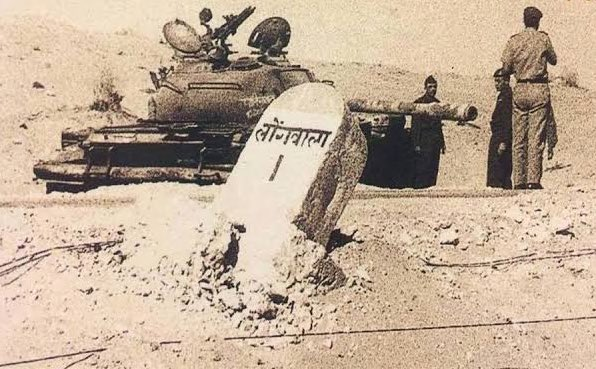
It is the epic tale of Battle Longewala, which is considered one of the first major engagements in the western sector during the Indo-Pakistani War of 1971. It is the story of the 120 soldiers of the Indian Army's 23rd Battalion, Punjab Regiment, commanded by Major Kuldip Singh Chandpuri, who bravely fought against 2000 to 3000 Pakistani soldiers. The 1971 War was incomplete without the Longewala battle. In 1971 war was one of the shortest military conflicts in history, lasting just 13 days. This war would lead to the creation of a new country, Bangladesh.
At that time, Pakistan's intelligence got a tip-off from their spy that India was preparing for war in East Pakistan, where the Pakistani military, led by Lieutenant General Tikka Khan, who later went on to become Pakistan’s first COAS, carried out widespread genocide against their Bengali citizens, particularly on the minority Hindu population in East Pakistan. Following the tipoff, in a fear of losing control over East Pakistan, the Pakistani army decides to attack India. However, they didn't know that India and Indian Army chief General Sam Manekshaw were waiting for Pakistan on a mistake that gave the reason for the war.
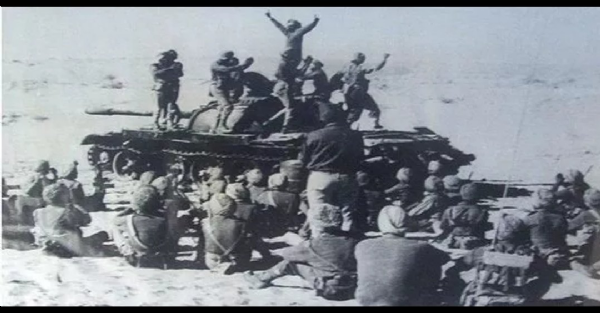
The hostilities between India and Pakistan formally began on December 3, 1971, at about 17:40, when the Pakistan Air Force (PAF) launched surprise pre-emptive strikes on eleven airfields in north-western India, including Agra, which was 480 kilometres (300 mi) from the border. On the evening of 3 December, 1971, All India Radio had informed its listeners that Pakistan had attacked Indian airfields at 5:45 p.m, and among them were the Jodhpur & Uttarlai airfields, which fell within Southern. Responding to the attack, the Indian Air Force carried out massive retaliatory strikes the next day, marking the official commencement of the war.
To build pressure on India, Pakistan decided to launch an attack on the Longewala. Longewala formed a strategic point en route to capturing vast tracts of land and also a pivotal theatre of war in engaging India on the western front. It was an important location because, if it fells, then the enemy would have captured vast swathes of Indian territory all the way up to Jaisalmer. The force aimed to move ahead for the capture of Ramgarh and Jaisalmer after Longewala was captured.
Pakistan’s generals knew that they wouldn’t be able to continue the battle for long due to international pressure. Hence, they hatched a plan to invade Longewala, Ramgarh, and Jaisalmer till morning. This motive forced them to launch an offensive during the night. A Combined Arms Plan was decided upon. This involved two Infantry Brigades and two Armoured Regiments. A separate division, the 18 Division, was formed for this purpose. 18 Division Operation Orders required one Infantry Brigade (206) with an Armoured Regiment (38 Cavalry) to capture and establish a firm base at Longewala, a junction on the Indian road system and 51st Infantry Brigade and the 22nd Cavalry (Pakistan Army Armoured Corps) to operate beyond Longewala to capture Jaisalmer.
As compared to the Pakistan army, the Indian force at Longewala was just one infantry company of fewer than 130 soldiers, with one jeep-mounted RCL gun, and MMGs and mortars.
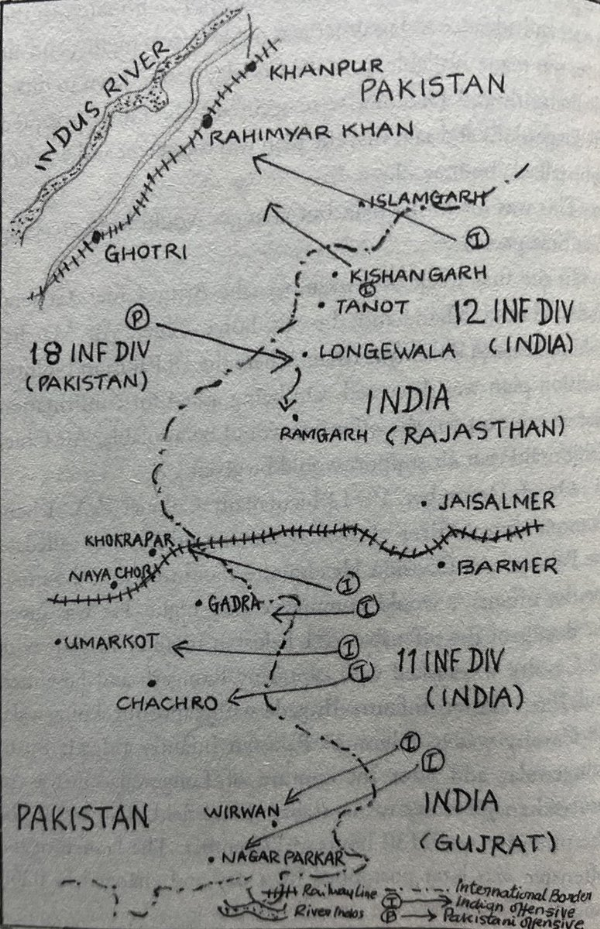
Following the plan, on the night of 4 December, the Pakistani offensive force led by Brig. Gen. Tariq Mir and Lt. Col Jahanzeb Abab approached the Indian Border Post No. 635, at around 2330 hours. On the night of 4-5 December, at around 2400 hours, 2Lt. Dharam Veer Bhan's platoon, while on a patrol, detected the sound of enemy armor. As soon as he alerted his Company Commander, Major Chandpuri who then reported developments to his battalion and requested urgent reinforcements and armour and artillery support. After getting reported that reinforcement in the form of Airforce was only possible the next day, he chose to defend the strategically important post to the last man and last round.
At 0030 hours, as the offensive approached the lone outpost, Pakistani artillery opened up across the border with medium artillery guns and killed five of the ten camels from the BSF detachment. Just before the shelling began, Major Chandpuri laid the mines around his post. Lacking the time to lay a prepared minefield, he used his cleverness and stretched a single strand of barbed wire across his front to indicate a deep minefield, which did not exist. He then adjusted the location of anti-tank weapons and went around all the bunkers to motivate his men.
The attack came at 12:30 am. When the Pakistanis approached the post, Lance Naik Mathura Das of 23rd Punjab Regiment, Indian Armed Forces, with the help of a 106mm M40 RCL gun destroyed the enemy tanks boosting the morale of the force. While another was destroyed by a mine. The Indians attacked the lighter top armour of the Pakistani tanks from their elevated position.
The initial Pakistani attack stalled almost immediately when the infantry discovered the barbed wire which was unseen in the night and interpreted it to signify a minefield. They lost precious hours as the Sappers were brought forward, only to discover there was no minefield. When the forward Infantry elements of the Pakistan Brigade were busy trying to probe the depth and extent of the minefield. Major Chandpuri’s company then knock out another Pakistani tank, while their medium machine gun and small-arms fire managed to keep the Pakistani force at bay. During which, the spare fuel tanks on tanks caught fire and lit up the battlefield, making it easier for the Indians to see the enemy.
Using all his years of experience Major Chandpuri tactfully kept the Pakistani army baffled thinking that the Indian troops were in large numbers. This sudden attack surprised the enemy and prevented it from getting close to the post, and although they didn’t come close, the enemy surrounded the post from all sides. This forced the Pakistan army to change its tactic. They decided to get off the road to attack from the other side. In that process, they however got bogged down in the soft sand and became easy targets for the Indian defenders. . Throughout the engagement, Maj. Chandpuri continued to direct the supporting artillery fire.
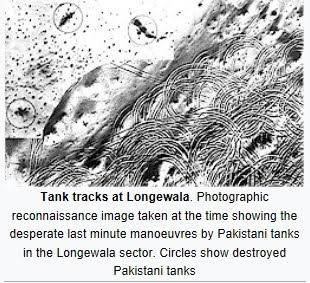
Although massively outnumbered, the accurate firing by the men of the 23 Punjab held off the Pakistani attack and by 5 AM the next morning. As the sun rose, help came in the form of Indian Air Force Hunter and Marut jets from the nearby airfield in Jaisalmer. The Indian aircraft attacked the Pakistani ground troops with 16 Matra T-10 rockets and 30 mm cannon fire on each aircraft. Without support from the Pakistan Air Force, which was busy elsewhere, the tanks and other armoured vehicles were easy targets for the IAF's Hunters. The range of the 12.7 mm anti-aircraft heavy machine guns mounted on the tanks was limited and therefore ineffective against the Indian jets.
An intercept of an enemy transmission by our army revealed the sagging morale of the Pakistani offensive force, indicating casualties in men and material, and SOS calls for close air support, without which the armour advance was considered impossible.
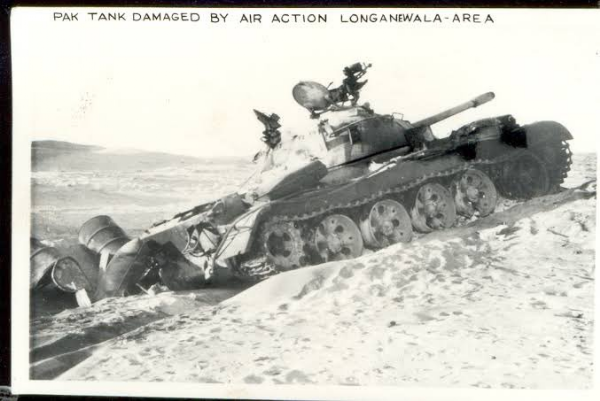
This is what the intercept said: (The enemy air force has made our lives miserable. Each aircraft comes and dances above for up to 20 minutes. 40% of our tanks and personnel have been destroyed. Not just going forward, even moving back has become difficult. Send our Air Force for immediate help, or else turning back will not be possible.)
By noon, IAF aircraft had decimated the attacking Pakistan force. Over 100 vehicles, including 22 tanks, were destroyed by the IAF. The Pakistani attack was first halted, and then Pakistani forces were forced to withdraw when Indian tanks from the division's cavalry regiment, the 20th Lancers, commanded by Col. Bawa Guruvachan Singh, along with the 17th battalion, Rajputana Rifles, launched their counter-offensive to end the six-hour engagement. Longewala had proved to be one of the defining moments in the war.
During the book release of"The Epic battle of Longewala", Indian Air Force chief Air Chief Marshal RKS Bhadauria said that the Pakistan Army’s plan of armoured thrust was brilliant, however, it didn’t factor in airpower. "Pak Army's plan of armoured thrust was brilliant. But they didn't factor in airpower and thought what half a squadron sitting in Jaisalmer would do, it was their mistake. Airpower can bring asymmetric results if time and place are chosen correctly," said IAF chief in the event at the Air Force Museum today. ‘
According to 122 Squadron, 78 enemy tanks were destroyed or damaged, and 2 armoured regiments of the Pakistan Army were rendered inoperative. The enemy had entered the Longewala battleground with 2 armoured regiments, consisting of 90 tanks, and by the end of the battle of Longewala, less than a squadron of enemy armour was left intact. A large number of enemy artillery guns and innumerable vehicles were also claimed as destroyed. The desert sands around Longewala became their burial ground. Longewala, in the district of Jaisalmer in Rajasthan, became the biggest graveyard of Pakistani armor.